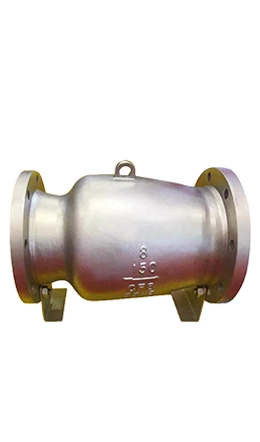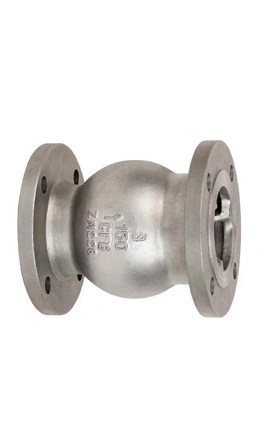Nozzle check valves are designed specifically for scenarios in which a fluid, gas, or slurry is pumped in a low pressure or otherwise intermittent flow. In particular, they are meant to close quickly and quietly during low pressure and no-flow periods, and can be used to reliably prevent the liquid, gas, or slurry from flowing in the reverse direction. Nozzle check valves are high performance and self-actuated regulating devices. These reliable non-return valves are designed specifically with demanding applications in mind. As such, this means they can react promptly to high deceleration rates with a non-slam performance, which minimises water hammer in reverse flow conditions.


The Nozzle Check Valve is designed to ensure efficient unidirectional flow control with specific performance features tailored to optimize functionality and reliability.
1. Unidirectional Flow Control
Ensures fluid flows in one direction only, automatically preventing backflow when flow stops or reverses, crucial for system safety and efficiency.
2. Low Pressure Drop
The nozzle-shaped flow path minimizes turbulence and resistance, reducing energy loss and maintaining system pressure efficiency.
3. Effective Sealing Mechanism
Utilizes precision-engineered sealing surfaces (e.g., metal-to-metal or elastomeric seals) to achieve leak-tight closure, preventing reverse leakage even under high-pressure conditions.
4. Rapid Response Time
Closes swiftly upon flow reversal or cessation, mitigating backflow risks. The nozzle design may enhance responsiveness through fluid dynamics or spring-assisted mechanisms.
5. High-Pressure and Temperature Tolerance
Constructed from robust materials (e.g., stainless steel, alloys) to withstand extreme pressures and temperatures without deformation or failure.
6. Durability and Corrosion Resistance
Materials like stainless steel, Hastelloy, or PTFE-lined components ensure longevity in corrosive or abrasive environments, reducing maintenance needs.
7. Cavitation and Noise Mitigation
Optimized nozzle geometry minimizes pressure fluctuations, reducing cavitation risk (bubble formation/collapse) and associated noise/vibration.
8. Minimal Maintenance Requirements
Streamlined design reduces susceptibility to clogging, while wear-resistant materials extend service intervals, ideal for critical or hard-to-access systems.
Nozzle check valves, combining flow regulation with backflow prevention, are utilized in various industries where precise fluid control and system protection are critical.
1. Hydraulic Systems
Function: Prevent backflow while controlling fluid velocity and direction.
Use Case: Ensures efficient operation of hydraulic machinery by maintaining unidirectional flow and optimizing pressure.
2. Fuel Injection Systems (Automotive/Aerospace)
Function: Atomize fuel and prevent backflow into injectors.
Use Case: Enhances combustion efficiency by ensuring fuel is delivered in a fine spray while protecting injectors from reverse flow.
3. Irrigation/Sprinkler Systems
Function: Maintain pressure, prevent backflow, and control spray patterns.
Use Case: Keeps systems pressurized for immediate use and avoids contamination from backflow.
4. Chemical Processing
Function: Handle aggressive fluids, enable precise dosing, and prevent corrosion.
Use Case: Safeguards pumps and equipment from corrosive backflow while ensuring accurate chemical distribution.
5. Oil and Gas Pipelines
Function: Regulate flow and prevent reverse flow in pipelines.
Use Case: Maintains pipeline integrity by preventing pressure surges and ensuring directional flow.
6. Firefighting Equipment
Function: Maintain hose pressure and direct water effectively.
Use Case: Ensures rapid deployment and consistent water delivery by preventing backflow when pumps are off.
7. HVAC Systems
Function: Control refrigerant flow and prevent efficiency loss.
Use Case: Optimizes refrigerant circulation in heat pumps and chillers, avoiding efficiency drops from backflow.
8. Steam Systems (Power Generation)
Function: Prevent condensate backflow and maintain steam velocity.
Use Case: Protects turbines and boilers from water hammer and damage caused by reverse flow.
